Key Points:
- Research found that 2,920 of the 7,000 to 8,000 bites from venomous snakes each year in the U.S. are from copperheads, making them responsible for around 39% of all reported venomous bites, which is more than any other snake.
- Copperheads’ venom contains hemotoxins that destroy red blood cells.
- Instead of retreating when sensing humans, copperheads freeze in an attempt to camouflage themselves. Because people don’t see them and step on or near them, they react by biting.
Copperheads are venomous pit vipers found in many parts of the southeastern United States. They grow between 20 to 37 inches in length and weigh no more than 12 ounces, making them perfectly medium-sized snakes. Copperheads get their names from their copper or orange-red heads that are triangularly shaped. They have pale brown to pinkish-brown background skins decorated with hourglass-shaped markings that are copper or reddish-brown.
Copperheads are said to bite more people than any other venomous snake in the United States. But is this true? And if it is, why? This article gives you all the answers you need to know.
Copperhead Snake Venom
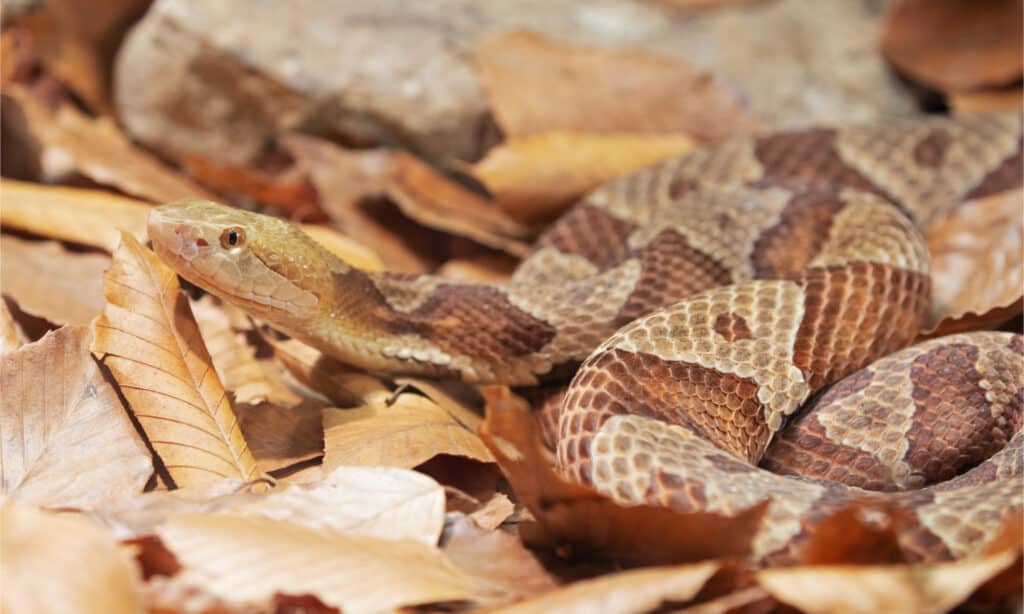
The venom of a copperhead contains hemotoxins that destroy red blood cells.
©DnDavis/Shutterstock.com
Copperheads’ venom contains hemotoxins that directly attack red blood cells. In large quantities, it can be fatal. However, the copperhead’s venom is rarely fatal. Copperheads have a maximum venom yield of 85 mg but only inject about 26mg on average. Since it takes 80 to 100mg of copperhead venom to kill a man, it is easy to see why copperhead bites are rarely fatal.
Do Copperheads Bite More People Than Any Other Snake?

According to the Centers for Disease Control and Prevention(CDC), about 7,000 to 8,000 people are bitten by snakes in the US each year.
©Creeping Things/Shutterstock.com
According to the Centers for Disease Control and Prevention(CDC), about 7,000 to 8,000 people are bitten by venomous snakes in the U.S. each year. Further research shows that about 2,920 of these bites were from copperheads. This makes them responsible for about 39% of all reported venomous bites in the U.S. No other venomous snake bites so many people in a year, so it is safe to say that copperheads bite more people than any venomous snake in America. But why is this so? Let’s find out.
Why Do Copperheads Bite More People Than Any Other Snake In The USA?

When copperheads freeze in an attempt to camouflage into their surroundings, humans fail to spot them and end up getting bitten.
©iStock.com/David Kenny
Copperheads bite mainly to warn or fight back against attackers. Most of their bites are warning or dry bites, meaning little to no venom is injected.
When most snakes sense or hear humans nearby, they slither away even before the human arrives. They do this to avoid making contact. However, when copperheads sense humans nearby, they do not slither away. Instead, they freeze in an attempt to camouflage into their surroundings.
The problem is that this works — a little too well. Humans do not spot these creatures and end up stepping on them or near them. This threatens copperheads and naturally, they react by biting.
Copperhead Bite
Copperheads make up for their lack of strong venom with excruciatingly painful bites. Their bites are often accompanied by nausea and swelling. Copperheads have long solenoglyphous fangs that tear through the skin and inject venom in a similar manner to how hypodermic needles work. The affected skin might turn black and fall off. However, if the bite is treated, most damage is reversible.
How Many People Die From Snake Bites Each Year?
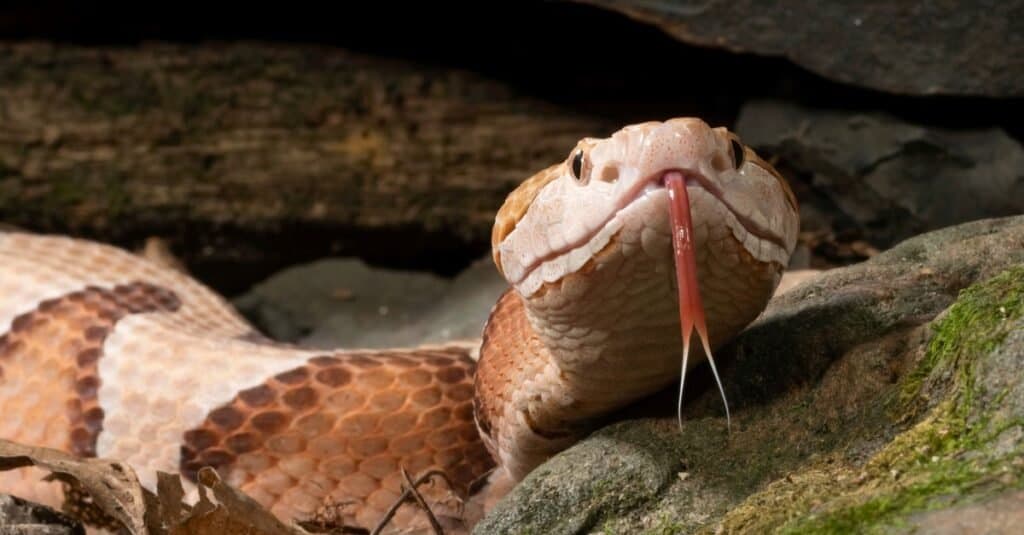
Copperhead snakebite deaths can occur when victims do not seek medical attention.
©Joe McDonald/Shutterstock.com
Copperhead deaths occur when victims do not seek immediate medical help because they underestimate the snake’s venom. Since only 0.01% of copperhead bites are fatal, we can estimate an average of one death every four years. This number is, of course, regrettable because getting treatment in time can save the victim’s life.
It is important to remember that although 99.99% of victims survive copperhead bites, the remaining fraction still represents people who never assumed they would be unlucky to fall into that segment. If you’re bitten by a snake, venomous or not, see a doctor immediately.
The CDC states that an average of five people die each year from snake bites. Considering copperhead death statistics (one in every four years), it is safe to say that copperheads are responsible for one in 20 deaths caused by snakes.
What to Do If You Come Across a Venomous Copperhead
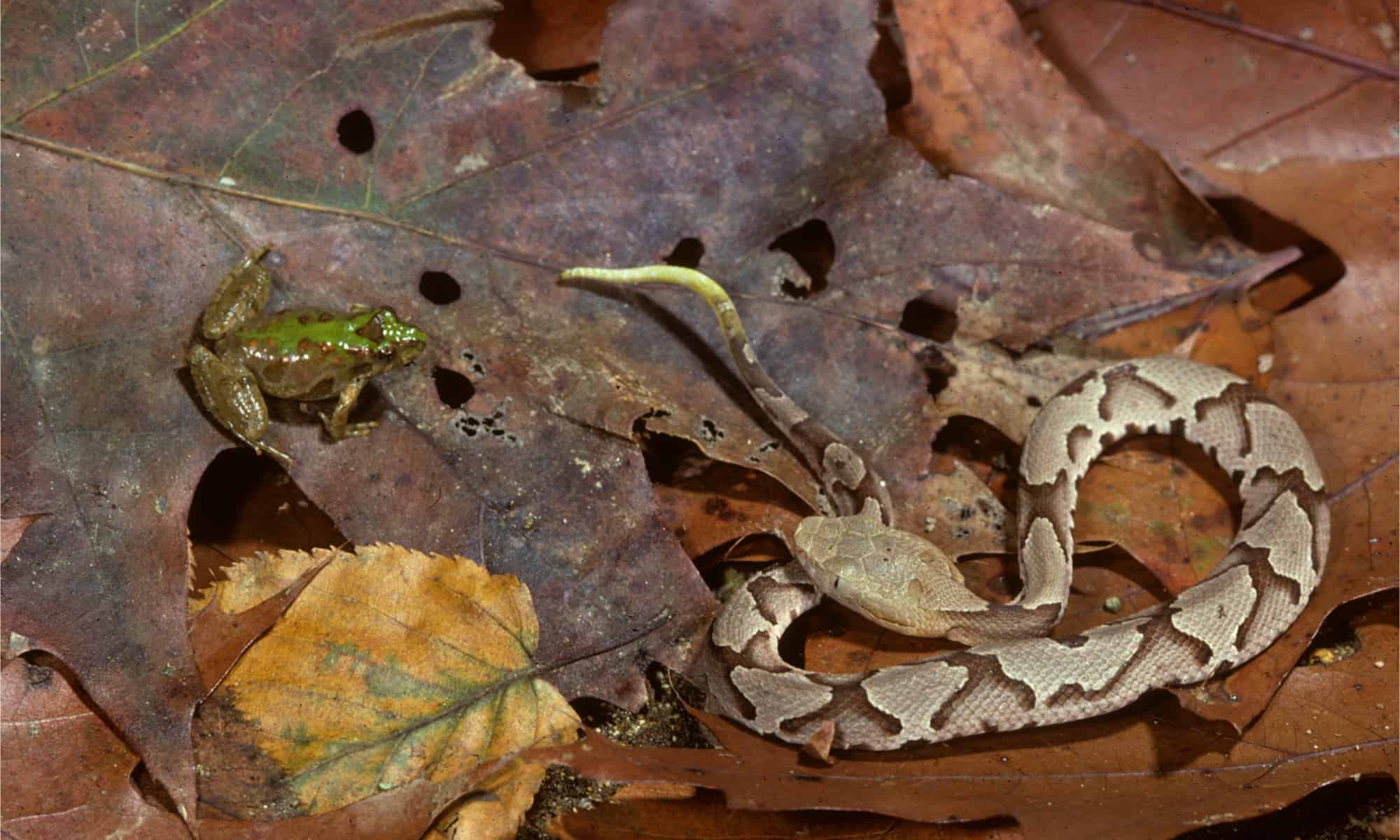
Copperheads will not attack unless they feel threatened so if you come across one, leave it alone.
©Breck P. Kent/Shutterstock.com
If you come across a venomous copperhead, leave it alone and respect its boundaries. Snakes, like all animals, are important and play an important role in the ecosystem. Copperheads will not attack unless they feel threatened, so it is important to ensure to avoid actions that can startle them. If you spot a copperhead in your home, calmly exit and contact a snake removal service.
How to Treat a Copperhead Bite
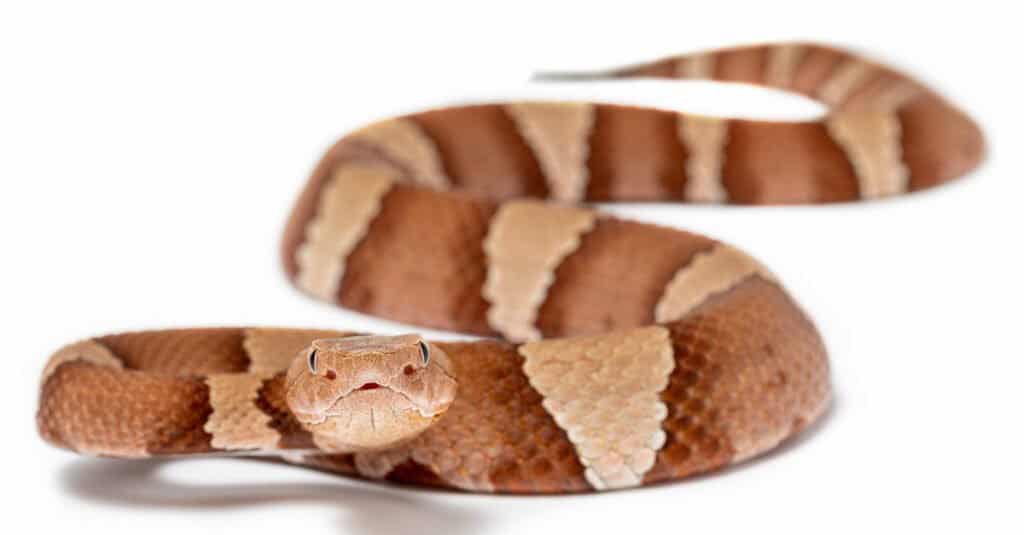
Although not usually deadly, copperhead bites need to be treated.
©Scott Delony/Shutterstock.com
If you’ve been bitten by a copperhead or any snake, do not attempt to treat yourself. Since snake venom is such a dangerous mix of toxins and chemicals, treatment is best handled by professional medical providers.
If you’ve been bitten by a copperhead snake, here are some tips to remember:
- Stay calm: Do not walk around, as that will help the venom circulate, and you do not want to do that.
- Contact emergency services: If you’ve been bitten by a snake, contact emergency services. Even if you are fairly certain of your ability to identify nonvenomous snakes and feel that you have been bitten by one, contact emergency services. Even nonvenomous bites can be infected. In addition, the misidentification of snakes is common. A lot of snakes, such as the coral snake, have lookalikes.
- Try to remember what the snake looked like. Being able to identify the snake you were bitten by will save the doctor time. However, if you can’t, don’t sweat it. Modern medicine is advanced enough to enable doctors to figure it out.
- Do not attempt to treat yourself: If you’ve been bitten by a snake, attempting to suck the venom out, applying a tourniquet, or cutting off the infected part will only make the situation worse. Do nothing and wait for help.
- Do not drink alcohol or take painkillers like aspirin because they thin the blood.
How you handle a snake bite situation greatly affects the outcome. Once you’ve contacted emergency health services and followed our other tips, stay calm and remember to breathe.
Other Venomous Animals That Bite Many People in the United States

Single hornets are not normally aggressive but the swarm will vigorously protect their queen and nests if threatened.
©Ruzy Hartini/Shutterstock.com
A hornet is a small insect in the wasp family that will become aggressive when it feels it, or its colony is being threatened and will respond in defense of either. While hornet venom is not generally considered toxic to humans, they release more venom than any other stinging insect and as a result of their size, the amount of venom they release can be very harmful. This wasp’s venom can cause issues with human tissue and the nervous system and according to the Centers for Disease Control, between 2000 and 2017, there were a total of 1,109 deaths attributed to hornets, wasps, and bees.
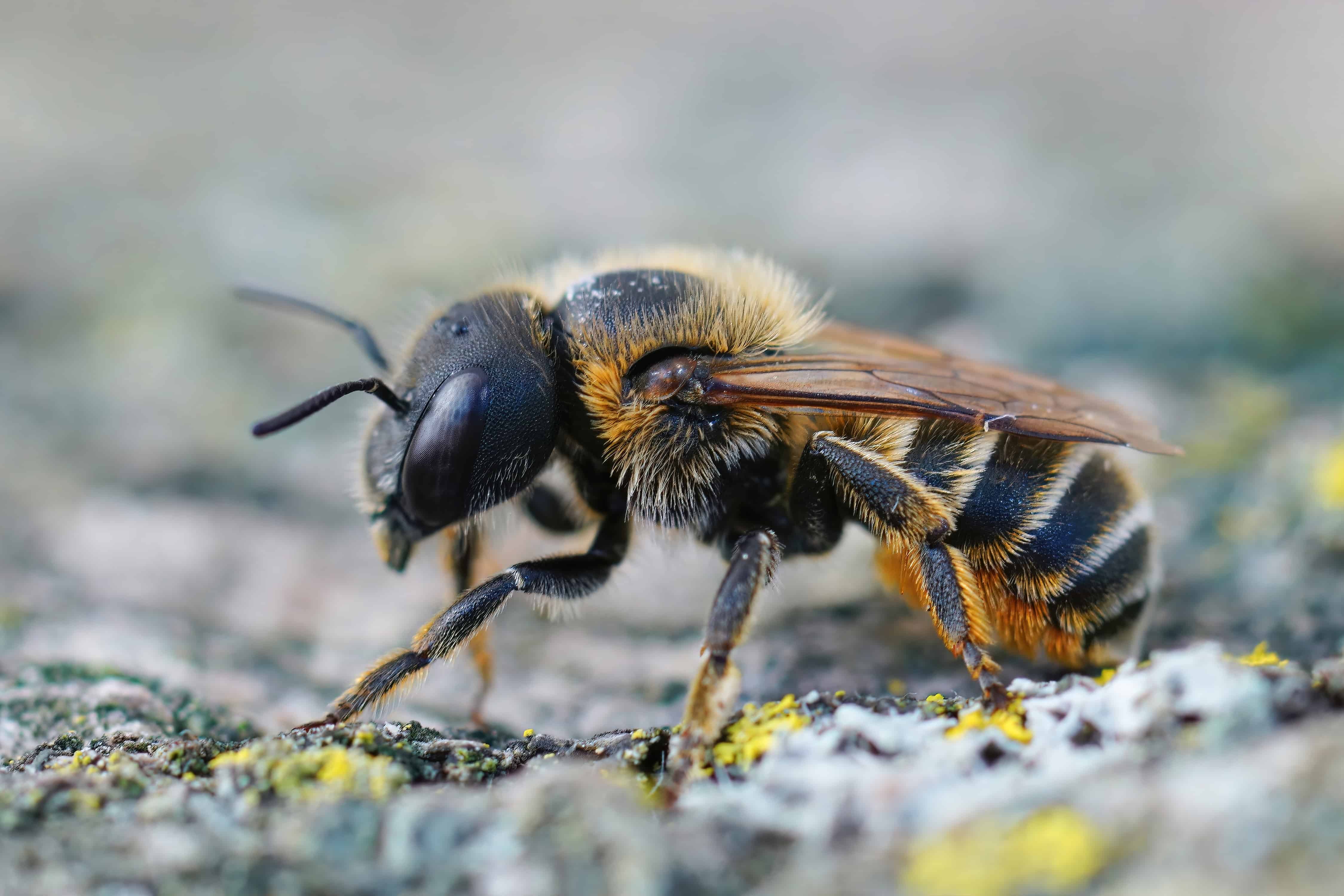
Bees are not aggressive but many people are allergic to the protein in their venom.
©HWall/Shutterstock.com
Falling into the same category as the hornet is the bee. This insect is not aggressive, and will only sting when threatened, in defense of their colonies when stepped on, or if they are confused. The majority of serious issues caused by bee stings are due to allergic reactions. The venom that bees carry has a protein that will affect a person’s immune system and skin cells and even those who are not allergic will feel certain effects, like itching and swelling, at the bite site. For those with allergies, these symptoms will be more severe and can even result in death.
The photo featured at the top of this post is © Wildvet/Shutterstock.com
Discover the "Monster" Snake 5X Bigger than an Anaconda
Every day A-Z Animals sends out some of the most incredible facts in the world from our free newsletter. Want to discover the 10 most beautiful snakes in the world, a "snake island" where you're never more than 3 feet from danger, or a "monster" snake 5X larger than an anaconda? Then sign up right now and you'll start receiving our daily newsletter absolutely free.
Thank you for reading! Have some feedback for us? Contact the AZ Animals editorial team.






